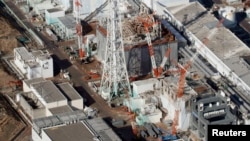Authorities at Japan's tsunami-damaged Fukushima Daiichi nuclear power plant have partially restored a crucial cooling system after it was shut down by an unexplained power outage.
The plant's operator, the Tokyo Electric Power Company (TEPCO), says equipment used to inject cooling water into spent fuel pools lost power late Monday, raising fears that temperatures could reach dangerous levels.
But TEPCO said, in a statement late Tuesday, the power supply was restored to part of the equipment. It says the cooling system at Reactor 1 has returned to full operation and that the systems at reactors 3 and 4 would likely be restored later in the day.
The company does not know what caused the power outage, but is investigating whether a broken switchboard is to blame.
There would be a danger of radiation spewing into the environment if the water in the spent fuel pools had reached a certain point. TEPCO officials say there has been no change in radioactivity levels.
The plant is still recovering from a massive earthquake and tsunami in March 2011 that shut off its power and cooling systems, causing a meltdown in three nuclear reactors. It was the world's worst nuclear disaster since the 1986 Chernobyl accident in the Soviet Union.
The plant's operator, the Tokyo Electric Power Company (TEPCO), says equipment used to inject cooling water into spent fuel pools lost power late Monday, raising fears that temperatures could reach dangerous levels.
But TEPCO said, in a statement late Tuesday, the power supply was restored to part of the equipment. It says the cooling system at Reactor 1 has returned to full operation and that the systems at reactors 3 and 4 would likely be restored later in the day.
The company does not know what caused the power outage, but is investigating whether a broken switchboard is to blame.
There would be a danger of radiation spewing into the environment if the water in the spent fuel pools had reached a certain point. TEPCO officials say there has been no change in radioactivity levels.
The plant is still recovering from a massive earthquake and tsunami in March 2011 that shut off its power and cooling systems, causing a meltdown in three nuclear reactors. It was the world's worst nuclear disaster since the 1986 Chernobyl accident in the Soviet Union.






